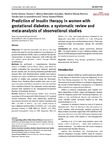Mostrar o rexistro simple do ítem
Prediction of insulin therapy in women with gestational diabetes: a systematic review and meta-analysis of observational studies
| dc.contributor.author | Álvarez-Silvares, Esther | |
| dc.contributor.author | Bermúdez-González, Mónica | |
| dc.contributor.author | Vilouta-Romero, Martina | |
| dc.contributor.author | García-Lavandeira, Sandra | |
| dc.contributor.author | Seoane-Pillado, Teresa | |
| dc.date.accessioned | 2022-10-26T10:57:38Z | |
| dc.date.issued | 2022-03-22 | |
| dc.identifier.citation | Alvarez-Silvares E, Bermúdez-González M, Vilouta-Romero M, García-Lavandeira S, Seoane-Pillado T. Prediction of insulin therapy in women with gestational diabetes: a systematic review and meta-analysis of observational studies. J Perinat Med. 2022 Mar 22;50(5):608-619. | es_ES |
| dc.identifier.issn | 0300-5577 | |
| dc.identifier.uri | http://hdl.handle.net/2183/31881 | |
| dc.description | Meta-análisis | es_ES |
| dc.description.abstract | [Abstract] Objectives: To identify antenatal risk factors that may predict the need for insulin treatment upon diagnosis of gestational diabetes (GDM), that is, to identify the specific characteristics of women diagnosed with GDM who did not achieve good glycemic control through lifestyle modifications. Methods: We performed a comprehensive literature search in PubMed, Science Direct, Ebsco, and Scielo for studies evaluating the associations between antenatal factors and the need for insulin treatment published until January 28th, 2021. Random-effects models were used to estimate risk ratios and their 95% confidence interval. The quality of studies was assessed using the Newcastle-Ottawa Scale. Random-effects models were used to estimate outcomes, and effects reported as risk ratio and their 95% confidence interval. The systematic review and meta-analysis were registered in the International Prospective Register of Systematic Reviews. Results: Eighteen observational studies were selected, reporting 14,951 women with GDM of whom 5,371 received insulin treatment. There were statistically significant associations between the need for insulin treatment and BMI ≥ 30 (RR:2.2; 95%CI: 1.44-3.41), family history of type 2 diabetes mellitus (RR:1.74; 95%CI: 1.56-1.93), prior personal history of GDM (RR:2.10; 95%CI: 1.56-2.82), glycated hemoglobin value at GDM diagnosis (RR:2.12; 95%CI: 1.77-2.54), and basal glycemia obtained in the diagnostic curve (RR: 1.2; 95%CI: 1.12-1.28). Nulliparity and maternal age were not determinants factor. There was moderate-to-high heterogeneity among the included studies. Conclusions: the strong causal association between BMI ≥ 30, family history of type 2 diabetes mellitus, prior history of GDM and glycosylated hemoglobin with the need for insulin treatment was revealed. | es_ES |
| dc.language.iso | eng | es_ES |
| dc.publisher | De Gruyter | es_ES |
| dc.relation.uri | https://doi.org/10.1515/jpm-2021-0247 | es_ES |
| dc.subject | Diabetes | es_ES |
| dc.subject | Drug therapy | es_ES |
| dc.subject | Gestational | es_ES |
| dc.subject | Insulin | es_ES |
| dc.subject | Meta-analysis | es_ES |
| dc.subject | Risk factors | es_ES |
| dc.title | Prediction of insulin therapy in women with gestational diabetes: a systematic review and meta-analysis of observational studies | es_ES |
| dc.type | info:eu-repo/semantics/article | es_ES |
| dc.rights.access | info:eu-repo/semantics/embargoedAccess | es_ES |
| dc.date.embargoEndDate | 2023-03-22 | es_ES |
| dc.date.embargoLift | 2023-03-22 | |
| UDC.journalTitle | Journal of Perinatal Medicine | es_ES |
| UDC.volume | 50 | es_ES |
| UDC.issue | 5 | es_ES |
| UDC.startPage | 608 | es_ES |
| UDC.endPage | 619 | es_ES |
Ficheiros no ítem
Este ítem aparece na(s) seguinte(s) colección(s)
-
GI-GIRS - Artigos [94]







